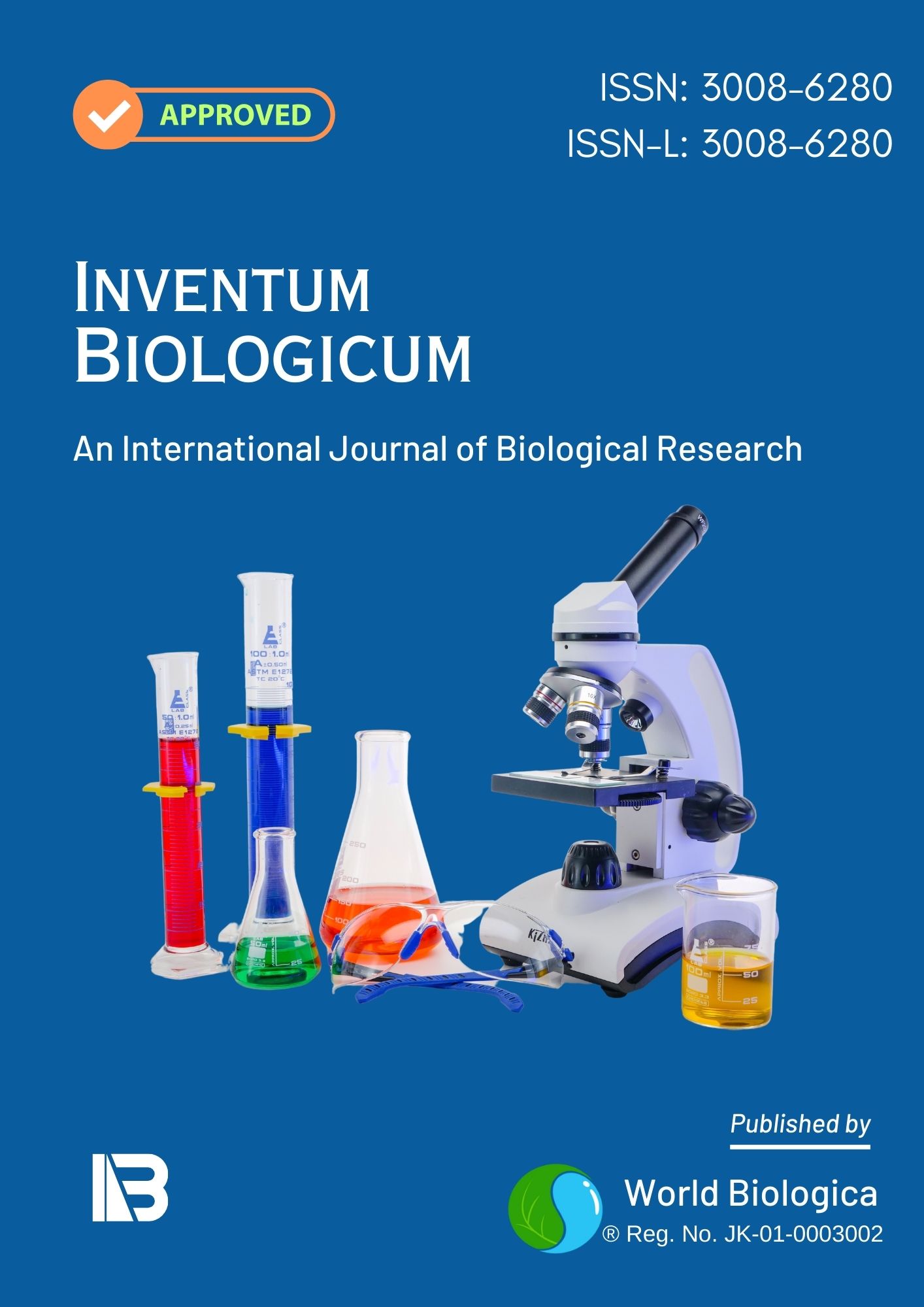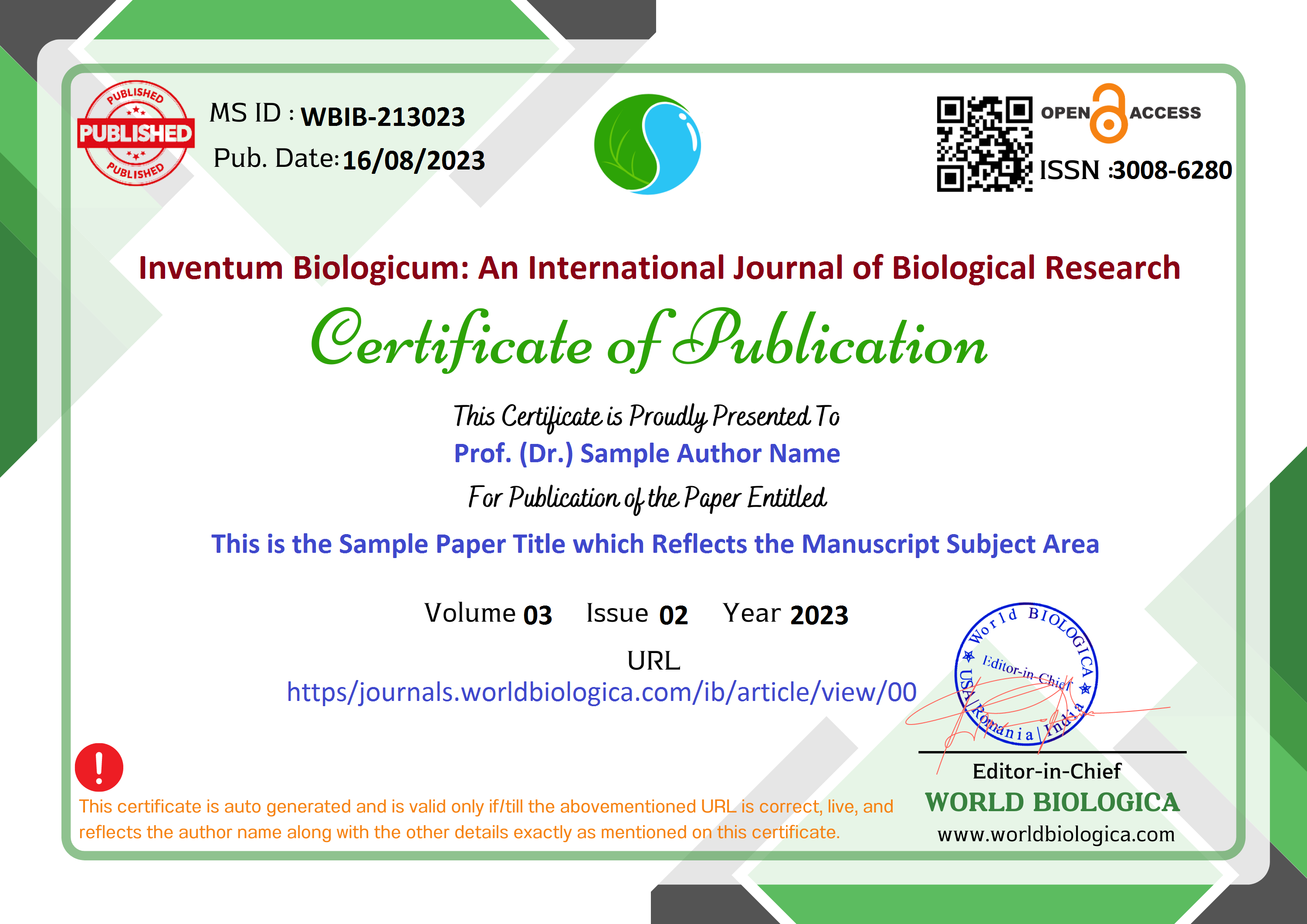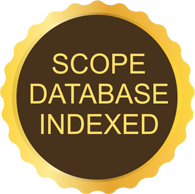Diversity of Zooplankton in the Lentic Ecosystem of Lake
Keywords:
Zooplanktons, Lentic ecosystem, Physico-chemical properties, Lentic lakeAbstract
Zooplankton are numerous organisms found in almost all water bodies. The study of plankton is a valuable method for assessing the biotic potential of water bodies and contributes to understanding their overall biological characteristics and economic potential. Zooplankton are microscopic, free-floating organisms that are crucial to the functioning of aquatic ecosystems. As a vital link in the energy transfer between phytoplankton and higher aquatic animals, zooplankton are key biotic components, playing a significant role in aquatic environments. They influence food chains, food webs, energy flow, and nutrient cycling in aquatic ecosystems.
Zooplankton populations serve as important indicators of the stability of food chains. Various environmental factors, such as pH, temperature, salinity, and oxygen levels, affect zooplankton populations. They play a critical role in the transfer of energy between primary and tertiary trophic levels. Additionally, zooplankton are indicators of the physical, chemical, and biological processes occurring in aquatic systems due to their high densities. Since they are highly sensitive to environmental changes, shifts in the abundance or composition of certain species can be used to assess the health of the ecosystem.
Downloads
References
Ahmad U, Parveen S, Khan AA, Kabir HA, Mola HRA, Ganai AH. 2011. Zooplankton population in relation to physico-chemical factors of a sewage fed pond of Aligarh (UP), India. Biol Med 3: 336-341.
Ahmad AK, Othman MS, Lim EC, Aziz ZA. 2013. Analisis kualiti air Tasik Chini menggunakan pendekatan multivariat. Sains Malaysiana 42 (5): 587-596. [Indonesian]
Awaludin AS, Dewi NK, Ngabekti S. 2015. Koefisien saprobik plankton di perairan Embung Universitas Negeri Semarang. Indones J Math Nat Sci 38 (2): 115-120. DOI: 10.15294/ijmns.v38i2.5780. [Indonesian]
Ayoade AA, Osuala BO, Adedapo TA. 2019. Physico-chemical parameters, chlorophyll a and phytoplankton community as trophic state indices of two tropical lakes, southwestern Nigeria. Eur Asian J Bio Sciences 13 (1): 15-22.
Bestová H, Munoz F, Svoboda P, Škaloud P, Violle C. 2018. Ecological and biogeographical drivers of freshwater green algae biodiversity: From local communities to large-scale species pools of desmids. Oecologia 186: 1017-1030. DOI: 10.1007/s00442-018-4074-x.
Browning TJ, Bouman HA, Moore CM, Schlosser C, Tarran GA, Woodward EMS, Henderson GM. 2014. Nutrient regimes control phytoplankton ecophysiology in the South Atlantic. Biogeosci 11 (2): 463-479. DOI: 10.5194/bg-11-463-2014.
Campillo S, García-Roger EM, Carmona MJ, Serra M. 2011. Local adaptation in rotifer populations. Evol Ecol 25: 933-947. DOI: 10.1007/s10682-010-9447-5.
Carlson RE. 1977. A trophic state index for lakes. Limnol Oceanogr 22: 361-369. DOI: 10.4319/lo.1977.22.2.0361.
Chen W, Ren K, Isabwe A, Chen H, Liu M, Yang J. 2019. Stochastic processes shape microeukaryotic community assembly in a subtropical river across wet and dry seasons. Microbiome 7 (138): 1-16. DOI: 10.1186/s40168-019-0749-8.
Dalu T, Froneman PW. 2016. Diatom-based water quality monitoring in southern Africa: Challenges and future prospects. Water SA 42: 551-559. DOI: 10.4314/wsa.v42i4.05.
Dhanalakshmi V, Shanthi K, Remia KM. 2013. Physicochemical study of eutrophic pond in Pollachi town, Tamilnadu, India. Intl J Curr Microbiol Appl Sci 2: 219-227.
Dhembare AJ. 2011. Diversity and its indices in zooplankton with physico-chemical properties of Mula Dam Water Ahmednagar, Maharashtra, India. EJ Exp Biol 1: 98-103.
Dullah H, Malek MA, Hanafiah MM. 2020. Life cycle assessment of nile tilapia (Oreochromis niloticus) farming in Kenyir Lake, Terengganu. Sustainability 12 (6): 2268. DOI: 10.3390/su12062268.
Gilbert JJ. 2017. Resting-egg hatching and early population development in rotifers: A review and a hypothesis for differences between shallow and deep waters. Hydrobiologia 796 (1): 235-243. DOI: 10.1007/s10750-016-2867-7.
Gökçe D. 2016. Algae as an Indicator of Water Quality. Algae-Organisms for Imminent Biotechnology. InTech, Rijeka, Croatia.
Gomes ML, Riedman A, O’Reilly S, Lingappa U, Metcalfe K, Fike DA, Knoll AH. 2020. Taphonomy of biosignatures in microbial mats on Little Ambergris Cay, Turks and Caicos Islands. Front Earth Sci 8: 387. DOI: 10.3389/feart.2020.576712.
Jaturapruek R, Fontaneto D, Maiphae S. 2020. The influence of environmental variables on bdelloid rotifers of the genus Rotaria in Thailand. J Trop Ecol 36: 267-274. DOI: 10.1017/S0266467421000018.
Stancheva R, Hall JD, McCourt RM, Sheath RG. 2013. Identity and phylogenetic placement of S pirogyra species (Zygnematophyceae, Charophyta) from California streams and elsewhere. J Phycol 49: 588-607. DOI: 10.1111/jpy.12070.
Striebel M, Singer G, Stibor H, Andersen T. 2012. “Trophic overyielding”: Phytoplankton diversity promotes zooplankton productivity. Ecology 93: 2719-2727. DOI: 10.1890/12-0003.1.
Taxböck L, Karger DN, Kessler M, Spitale D, Cantonati M. 2020. Diatom species richness in Swiss springs increases with habitat complexity and elevation. Water 12: 449. DOI: 10.3390/w12020449.
Teittinen A, Kallajoki L, Meier S, Stigzelius T, Soininen J. 2016. The roles of elevation and local environmental factors as drivers of diatom diversity in subarctic streams. Freshw Biol 61 (9): 1509-1521. DOI: 10.1111/fwb.12791.
Barhate VP (1985). Studies on the Algal flora of Vidarbha and Khandesh Maharashtra, Ph.D Thesis, Nagpur University, Nagpur.
Basu BK, Pick FR (1996). Factors regulating phytoplankton and zooplankton development in a temperate rivers. Limnol. Oceanogr. 41: 1572-1577.
Bhivgade SW, Taware AS, Salve US, Dhaware AS (2010). Limnological studies on some aspects of Nagzari Tank, Ambajogai, District Beed, Maharashtra. J. Aquat. Biol. 25(2): 4 – 7.
Burić Z., Cetinić I., Viličić D., et al. Spatial and temporal distribution of phytoplankton in a highly stratified estuary (Zrmanja, Adriatic Sea). Mar. Ecol. 2007;28(Suppl. 1):169-177.
Descy JP, Gosselain V (1994). Development and ecological importance of phytoplankton in a large lowland river (River Meuse, Belgium). Hydrobiologia 289: 139 – 155.
Dutta SP, Sharma S, Chowdhary S (2009). Ecology of plankton in some surface water irrigated paddy fields of Gurha Brahmana, Akhnoor,
Kobayashi T, Shiel RJ, Gibbs P, Dixon PI (1998). Freshwater zooplankton in the Hawkesbury – Nepean River: comparison of community structure with other rivers. Hydrobiologia 377: 133- 145.
Korovchinsky AA, Petrusek K, Forro NM (2008). Global Diversity of Cladocerans. J. Hydrobiologia 595:177 – 184.
McHugh DJ (2003). A guide to the seaweed industry. Rome, FAO. FAO Fisheries Technical Paper, No. 441.
Pace ML, Findlay SE, Lints D (1992). Zooplankton in advective environments: The Hudson river community and a comparative analysis. Can. J. Fish. Aquat. Sci. 49: 1060 – 1069.
Patil SG, Singh DB, Harshey DK (1983). Ranital (Jabalpur) sewage polluted water body as evidence by chemical and biological indicators of pollution. J. Environ. Biol. 4(2): 43 – 49.
Peretyatko A, Teissier S, Symoens JJ (2007). Phytoplankton biomass and environmental factor over a gradient of clear to turbid peri – urban ponds. Aquat. Conserv: Mar. Freshwater Ecosyst, 17: 584 – 601.
Piirsoo K, Pall P, Tuvikene A (2008). Temporal and spatial patterns of phytoplankton in a temperate lowland river (Emajogi Estonia) J. Plankton. Res. 30: 1285 – 1295.
Prescott GW (1939). Some relationship of phytoplankton to limnology and Aquatic biology in problems of lake biology. Amer. Assoc. Adv. Sci. 10: 65 - 78.
Raghunathan (1983). Study on some planktonic Cladocera of Tamil Nadu. Ph.D. Thesis. Madras University.
Downloads
-
Download PDF
 Abstract Views: 166,
Abstract Views: 166,  Download PDF: 97
Download PDF: 97
Published
How to Cite
Issue
Section
License
Copyright (c) 2024 Inventum Biologicum: An International Journal of Biological Research

This work is licensed under a Creative Commons Attribution-NonCommercial-NoDerivatives 4.0 International License.


















